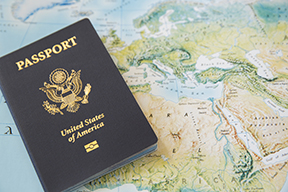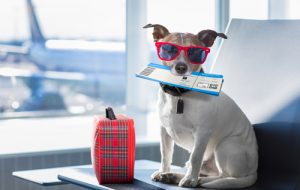Say Cheese! Taking a Look at Passport Photo Requirements
Updated As of read 5 min

Picture this: you’ve just booked an international vacation, and you’re already counting down the days. You apply for a passport ASAP because you don’t want any hiccups.
Then disaster strikes. Two months later, your trip is three weeks away, and you find out your passport application was denied. Is it because you have a long-lost identical twin with arrest warrants?
Nope. It’s because your head is crooked in your passport photo.
Passport photos have very strict requirements. In fact, photo problems are among the most common reasons passport applications are delayed or denied. To avoid this problem, read up on these photo requirements:
U.S. Passport Requirements
- The photo must be taken within the last six months.
- The background of the photo should be plain white or off-white with no shadows.
- Your face must be square to the camera, and your eyes open directly at the camera lens.
- You cannot wear anything that covers your face (except for religious attire).
- Your head must be centered and not tilted or rotated in any way.
- Your face should take up about 50% of the frame, with room for your hair on the sides.
- You cannot wear glasses (unless you have a medical or religious reason to do so).
- The photo should be taken at eye level, not from below or above.
- The photo should be taken in focus and in natural color (no filters).
- Your expression should be neutral with your mouth closed (no smiling, frowning, etc.).
Once these requirements are met, you can upload your passport photo! Keep in mind that the photo must also meet certain technical specifications;
Does it Matter How you look in a Passport Photo?
To make your photo identifiable, there are restrictions on almost every aspect of your picture. For example, you cannot have your hands crossed in the photo. Your hair must be pulled away from your face, and it can’t be covering any part of your eyes. Your facial expression must remain neutral, and you need to maintain direct eye contact with the camera.
What is the Facial Expression on a Passport Photo?
In years past, you had to have a neutral facial expression in your photo: a resting face. However, that rule has changed. You can now smile in your passport photo, as long as it’s a natural smile.
You are still not permitted to make any facial expressions besides a natural smile or neutral resting face, however. Kids and babies can’t be crying in their photos, so be prepared for several re-dos.
You also need to have both eyes open in your passport photo, with no squinting. Young infants and newborns are an exception to this rule.
Related Read: Cheapest Place to Get a Passport Photo Near Me
Attire
In your passport photo, you need to wear the type of clothing you wear daily. There are more specific regulations about your attire from the neck up, though:
Headwear
For the most part, you can’t wear a hat or headwear. There are two exceptions to this rule. If you wear a head covering as a custom of a recognized religion, it is permitted in your photo. However, you must include a signed statement explaining this in your passport application.
You can also wear a head covering if you need to wear it daily for medical purposes. In this case, you need a signed note from a doctor explaining this in your application.
It can’t obscure your face even if you wear a head covering for one of these reasons. It needs to show your full face clearly and can’t cast shadows on your face.
Glasses
Until a recent change, you could wear glasses in your photo as long as there was no glare on them. However, this has recently changed. Glasses are no longer permitted in passport photos.
In addition to these rules, you can’t have anything obscuring your face in your photo. For instance, babies can’t have a pacifier in their mouths and your hair can’t be in front of your face. You also can’t wear headphones or in-ear devices other than hearing aids.
Framing
Your final photo must be two inches wide and two inches tall, but there are also specific restrictions about the framing. Your face must be between one inch and 1.4 inches tall. Standing four feet from the camera will usually give you the right size.
The photo must show your entire face, which must be centered. You must also be at a straight-on angle with your shoulders squared to the camera. Your head can’t be tilted or turned in any way.
Background
You need to take your photo against a plain background that is white or off-white. The background can’t have texture. For example, a white brick wall is not acceptable. The photo also needs to have adequate lighting without shadows on your face.
This can be tricky when it comes it an infant’s photo. If you have a baby, you can’t hold your baby for his/her photo. The easiest method is to put your baby on a white blanket or in a car seat with a white blanket behind him/her. Keep in mind that the blanket needs to be inside the car seat, not behind it.
Quality
While it doesn’t need to be a work of art, your picture must be of high quality. It can’t be blurry or grainy, and it can’t have any motion blur.
The picture can’t be stretched to meet the correct dimensions because this distorts your face. You also can’t have red-eye in the photo, because this blocks your eye color.
Unaltered
As much as you may want to look thinner or more attractive in your new passport, you can’t digitally alter the photo. You can’t use any retouching, nor can you crop your face out of another photo to give it a white background.
In a similar vein, your photo needs to be from the past six months. The only acceptable altering is to crop the photo to the required size and remove the red-eye.
The Finished Product
It might be 2023, but passport photos still need to be in printed form. They must be printed in full color on matte or glossy photo paper. Many people choose to go to a drug store with a photo lab because these stores often have passport photo stations and can print your photo according to regulations.
Taking a Successful Passport Photo
When taking a passport photo, it’s not about getting the right look or a flattering angle. Knowing the regulations for your passport photo and following them to the letter can help your application get approved in as little time as possible.
Now that you know how to ace your passport photo don’t forget the other complex aspects of the application process.
Conclusion
Taking the right passport photo is important when applying for a US passport. Following specific regulations and guidelines can help your application get approved in as little time as possible. Visiting a drug store with a photo lab or using online services are great options to ensure you get the best results for your passport photo.
For more information on submitting a successful application, check out our US passport tips blog. With the right preparation and understanding of the process, you can get your passport in no time!
Good luck!



